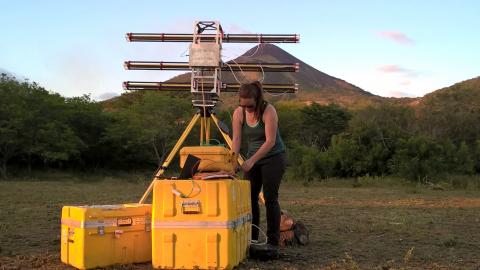2015-12-10: USF Volcanology Team responds to volcanic unrest in Nicaragua

Glenn Thompson travelled to Nicaragua on December 10th to deploy seismic and infrasound stations on Masaya volcano in co-ordination with scientists and technicians from INETER. Thompson was part of a larger USF effort with other team members being Chuck Connor, Laura Connor, Rocco Malservisi, Tim Dixon and graduate student, Lis Gallant (pictured).
For more pictures, follow this link
INETER volcanologist Armando Saballos, a former PhD student of Chuck Connor, had previously asked Steve McNutt and Thompson to provide training in volcano-seismology and volcano-seismic data analysis software. Then on 2015/12/01, Momotombo Volcano erupted on December 1st for the first time in over 100 years, prompting the USF response. The main USF party travelled on December 5th and focused on using a radar instrument (pictured) to generate high resolution digital terrain models of an active lava flow. Thompson needed to test and calibrate seismic and infrasound sensors at USF before traveling, and arrived on December 10th.
By this time, INETER had reoccupied several former seismic stations on Momotombo and former USF professor Diana Roman (now Carnegie Institute) arrived on December 9th to relocate several of her stations from Telica Volcano to Momotombo. In addition, Peter LaFemina (Penn State) had deployed several GPS stations. However, on the morning of December 11th, Masaya Volcano, on the outskirts of Nicaragua's largest city and capital Managua, began to show signs of unrest and so instead Thompson (working with INETER seismologist, Wilfried Strauch) deployed two stations on Masaya. The first was station MASN, with one seismic sensor and three infrasound sensors, and the second was a seismic station (LTUN; no infrasound) in a lava tunnel close to the active lava lake and tremor source. Data from MASN were successfully telemetered to INETER's operations room and the station will remain in the field. LTUN was only a temporary deployment.
Another group that visited at this time were Randy White and Wendy McCausland of the USGS Volcano Disaster Assistance Program (VDAP). Their main role was to provide additional expertise in volcano-seismic data interpretation, and eruption forecasting, and relay this information to the Nicaraguan government. White has a 40-year history of assisting INETER, having installed the first seismic network in the mid-1970s.
The main USF team returned to Tampa on December 10th/11th, while Thompson returned December 18th.
- Log in to post comments